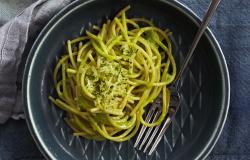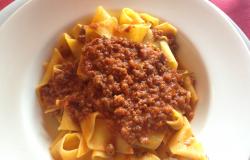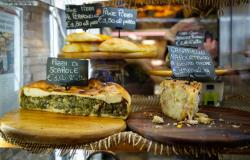Spätzle with Butter, Speck and Leek

Spätzle are common to many German-speaking areas of Europe, including Italy's Südtirol (South Tyrol) or Alto Adige region. The name for these flour and egg-based dumplings is thought to derive from the Swabian word spätzen, meaning 'little sparrows'. Before utensils like spätzle boards and presses were invented, spätzle were almost exclusively shaped by hand or a spoon. The results were said to resemble these tiny birds.
Made by combining flour, eggs and water (or milk) into a thick, runny batter, spätzle are surprisingly quick and easy to make, provided you got a spatzle maker of some kind on hand. In fact, it's one of those rare cases of a fresh pasta being the perfect dish for a weeknight dinner! If you become a fan of making these delectable dumplings like I have recently, do look out for a wooden spatzle board and scraper or, my personal favourite, the spätzlehobel. This is a stainless steel press resembling a cheesegrater with large holes and a slideable hopper attached. Simply fill the hopper with batter and then slide it back and forth over the holes to create the dumplings. Otherwise, a simple potato ricer or a pasta colander with large holes can be placed on top of your saucepan instead.
Readers with origins in Alsace, Moselle, Switzerland, Austria and Germany may be more familiar with spätzle as a side dish to a main course. An Instagram follower originally from Alsace, for instance, was kind enough to share some of the ways she ate these warming and comforting dumplings as a child: '(as) a side to a main... often with meat in white wine and cream sauce like coq au riesling or veal escalope with mushroom and cream sauce...'. In Alto Adige and the Val Camonica and the Valtellina in neighbouring Lombardy though, these dumplings are generally served as a starter, in broth, or with a sauce or condiment, such as cream or butter.
In the following recipe, I've opted for a simple condiment made by melting butter and sauteeing fine strips of sesaonal leek and speck, a dry-cured, lightly-smoked ham typical of the Alto Adige region. Do remember to ask for a thicker slice at your local delicatessen, if you're able to get your hands on this aromatic and flavourful prosciutto. This way, you'll be able to achieve an attractive lardon-like shape . If, however, you aren't able to source speck, salty pancetta also works well. As for the flour used, I've had excellent results with stonemilled wheat, spelt and the more traditional buckwheat. I've therefore suggested all three as possibilities in the recipe below. And, for those desirous of even richer dumplings, milk can substitute the water indicated as well. A nourishing and comforting dish, perfect for the cold and snowy turn the weather has taken in northern Italy recently!
Ingredients (serves 4 as an starter)
In a large bowl, beat eggs and water. Add flour and a pinch of fine sea salt in a slow steady stream to avoid forming lumps. Whisk until batter is smooth, cover and set aside.
In a wide skillet or saute pan, melt a large knob of butter on low to medium heat. Add finely cut strips of leek and allow to cook until soft and translucent, about 5-7 minutes. Add strips of speck and leave to simmer until their fat has rendered, about 5 – 7 minutes.
In the meantime, place spätzlemaker on top of a saucepan containing boiling salted water. Pour a large spooonful of batter into the spätzlemaker's hopper and slide it back and forth over the holes until drops of batter fall into the gently boiling water. Those droplets of batter will quickly firm up and float to the surface quite quickly. Using a slotted spoon, drain and transfer the spatzle to the sauteeing leek and speck. Repeat until all you have used all the spätzle batter.
Toss spätzle, leek and speck gently over low to medium heat. Taste for salt (speck is quite salty so best to skimp on this), remove from heat and serve immediately in warmed pasta plates.






